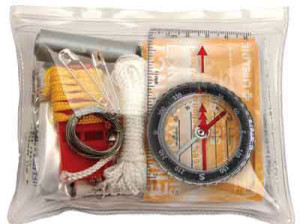By Chris Erwin
If you are someone who spends time in the outdoors, hiking, fishing, hunting, bird-watching or anything else that puts you in the woods: I can answer that question for you. Yes you do!
They don’t have to be large, many are so small you can put them in a Mentos can or a small bag that can go in your backpack. I keep one in my boat, and it’s a lot more complete but having even a small one could save your life.
Any time you’re in the woods you can get lost or fall and get injured. If you happen to be in a place with no cell phone service, you may need to be able to spend the night or even a few days until you can either walk out or someone finds you.
This has happened to me a few times, both hunting and fishing. I realize I spend a lot more time in the outdoors than most of you, but it only takes one time to find yourself lost, hurt or stuck somewhere you can’t just call for help.
I thought I would use this space this week to cover a small kit that you can use in the woods or in your boat in case you find yourself in this predicament.
When we discuss what is needed, that list can grow very quickly and if you know you are putting yourself in that position you need to carry all you can. However, if you are preparing for the unintended mishap that might find yourself in a position you never intended, you still need the very basics to stay alive.

Every survival kit should include a basic first-aid kit even if it’s a very small one because getting injured can be the very reason you find yourself in this position. I won’t go into to that in this article. My suggestion is to take all you can carry without it being a burden. Secondly, you need something to collect water in and this can be as simple as a gallon plastic bag. It goes without saying, you should always carry a pocket knife.
One of the basic rules you learn in survival training is the rule of 3s. You can live three minutes without oxygen, three minutes in freezing water before hypothermia sets in, three hours without shelter in extreme heat/cold, three days without water and three weeks without food.
This rule should set your priorities when you find yourself in trouble. And just let me assure the rule of 3s will test your resolve if you take any of them to their limit.
Any basic kit must help you to overcome the basic rules to stay alive. You need something to treat water. You can get that in a pill form or a tincture of iodine to disinfect water, use five drops per quart. Both are cheap. There are some filters, but I’m not going to cover them in this article.
You also need something to start a fire with. If that is a lighter, it should be a bright-colored one that won’t get lost in high grass if you drop it. Some people carry a flint and steel striker on their key chain. You can carry a cotton ball as tender, making starting a fire easier. I know you’re going to laugh here but one of the things that work the best for this is dipping a tampon in Vaseline and then storing it in a plastic bag. Its starts like a match and will burn for 15 minutes giving you time to get your fire going.
I also have a bracelet made of parachute cord that I wear. This thing can unwind to 10 foot of cord. This can be used for anything from building a shelter to trapping food. Either way, some kind of cord should be on your list.
Another thing I highly recommend is a small flashlight with extra batteries. Along with that I pack a tea-light, these are the little candles that come in a tin. When building a fire you can light this little tea-light and save your lighter or matches plus at night, it saves your flashlight once you secure a shelter.
You should also have a compass, and a map would be nice. You need to know if you get lost that you’re not walking in circles if you plan to walk out.
You can also add a Survival Wire Saw. They are very cheap and don’t take up much room, but if you need to make a shelter they come in handy.
If you get lost or injured, your very first decision is: Do I try to walk out or do I hole up until morning? It usually takes two hours to build a quick shelter, and it’s not that fun after dark. Take the time to be prepared if you spend time in the woods or secluded water ways.


Be the first to comment